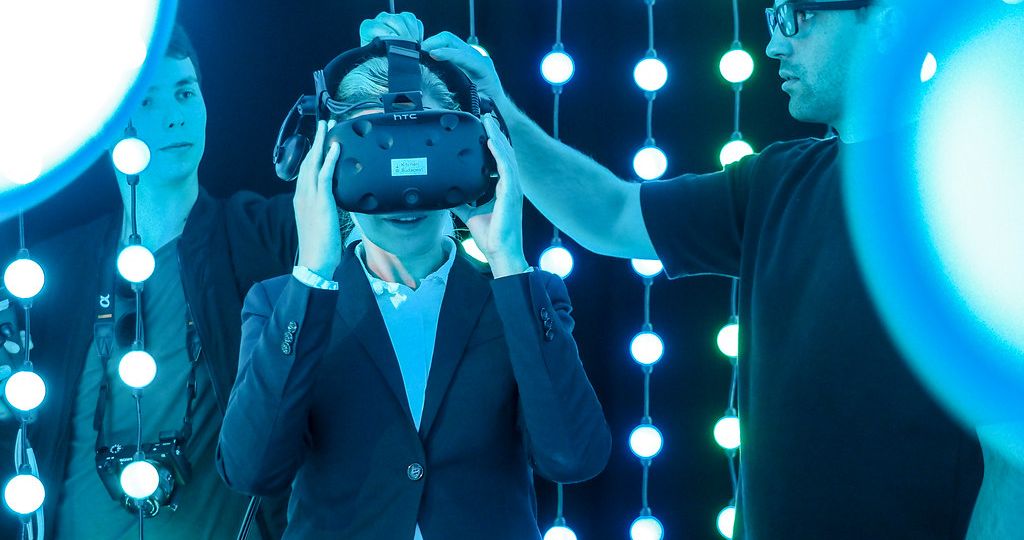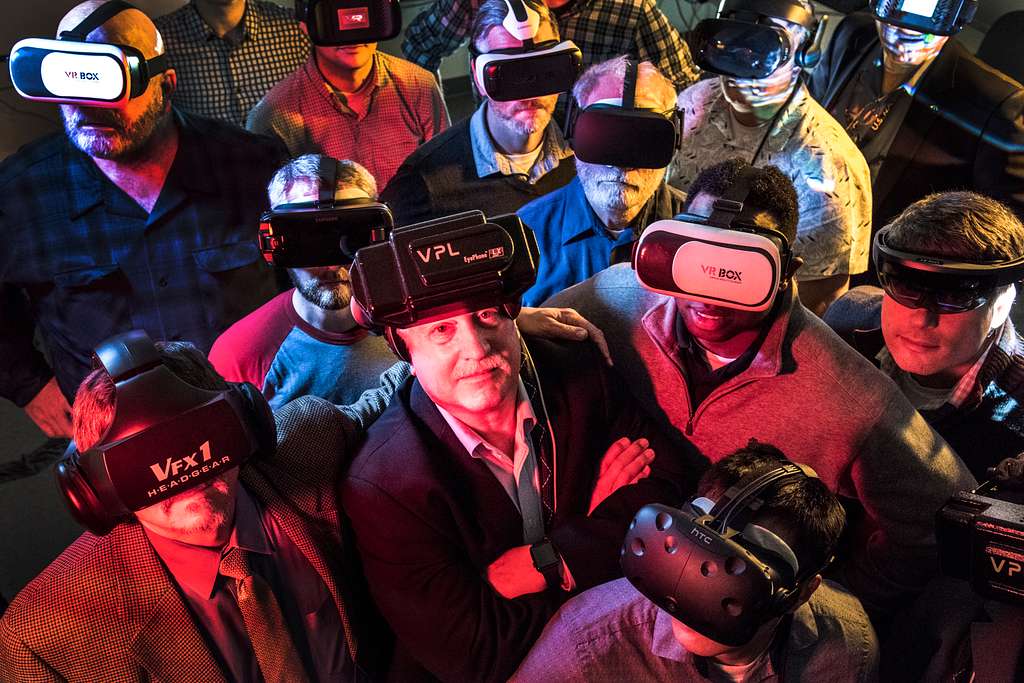
In the realm of advanced training methodologies, Augmented Reality (AR) and Virtual Reality (VR) have emerged as frontrunners, heralding a new era of immersive learning. Despite their potential to revolutionise training across various sectors, AR and VR have yet to achieve mainstream adoption in educational and professional settings.
The current landscape of AR/VR training is a tapestry of innovation and experimentation. These technologies offer immersive experiences that can transform how knowledge is imparted and skills are honed. AR overlays digital information onto the physical world, enhancing the learning environment with interactive elements. VR, on the other hand, transports users into entirely virtual spaces, allowing for deep immersion in simulated scenarios. Together, they represent a significant leap from traditional training methods, providing interactive, engaging experiences that can be tailored to specific learning objectives.
However, the journey of AR/VR from niche to mainstream has encountered several hurdles. Despite their proven efficacy in areas like medical training, military simulations, and industrial skill development, these technologies have not been universally embraced. The gap between their potential impact and actual widespread adoption is shaped by a range of factors – from technological to financial, from ergonomic to psychological.
As we delve into the intricacies of AR/VR training adoption, it becomes clear that overcoming these barriers is not just about technological advancements but also about addressing the nuanced aspects of user experience, cost, and accessibility. The future of training and education hinges on how effectively these challenges are navigated and resolved.
In this blog, we explore the barriers to mainstream VR adoption, understanding their roots and contemplating the strategies to overcome them, paving the way for AR and VR to fulfil their promise as transformative tools in the world of training and education.
Understanding the Barriers
The journey of AR and VR training toward mainstream adoption is impeded by a multifaceted array of barriers. These challenges span from practical constraints to more nuanced perceptual issues.
Production Complexity: The creation of high-quality immersive content is both cost and labour-intensive, involving a blend of technical skills and creative insight. This complexity can be a significant deterrent, especially for smaller organisations or those with limited technological infrastructure.
Prior Disappointing Experiences: Early AR/VR adopters might have experienced poorly designed applications, leading to a tainted perception of the technology’s potential. Such negative experiences can foster scepticism and reluctance to revisit or reinvest in newer, improved versions.
Device Diversity and Complexity: The range of AR/VR hardware, each with unique features and varying technical requirements, can be overwhelming. This diversity, while beneficial in catering to different needs, can complicate the decision-making process for potential users and slow down adoption.
Comfort and Accessibility Concerns: For many, wearing AR/VR headsets raises concerns about comfort, hygiene, and potential physical side effects like motion sickness. Such apprehensions can inhibit individuals and organisations from embracing this technology.
Lack of Content Standardisation: The absence of standardised content formats across different VR platforms can lead to compatibility issues, making it challenging for users to access various training materials seamlessly.
Technological Intimidation: The perception of AR/VR as highly advanced technology can be intimidating for non-tech-savvy users, creating a psychological barrier to adoption.
Limited Demonstrated ROI: Without clear, widely publicised examples of successful ROI from AR/VR training, organisations may hesitate to allocate budgets to these technologies, preferring to invest in more traditional, proven training methods.
Addressing these barriers is crucial for the widespread adoption of AR/VR training. It requires a concerted effort from technology developers, content creators, and industry advocates to simplify production, improve user experience, standardise content, and clearly communicate the tangible benefits of AR/VR training. As these challenges are progressively overcome, AR and VR are poised to revolutionise the landscape of experiential learning and training.
Cost Implications
One of the most tangible barriers to AR/VR training adoption is the financial aspect. We in the VR training industry are convinced of cost reductions companies can make in their training budgets by adopting VR. However, implementing AR/VR training requires an upfront investment in both hardware and software. For many organisations, particularly small to medium-sized enterprises, this cost can be prohibitive. Beyond the initial purchase, there are ongoing expenses related to content creation, hardware maintenance, and software updates. The challenge lies in convincing stakeholders of the long-term value and ROI that AR/VR training offers over traditional methods.
User Accessibility and Comfort
User accessibility and comfort present another significant challenge. Design ergonomics plays a crucial role in how users interact with AR/VR technology. Poorly designed headsets can lead to physical discomfort, such as neck strain or eye fatigue, limiting the duration users can engage with the training. Motion sickness, a common side effect experienced by some VR users, is another critical issue that needs to be addressed through better hardware design and content creation practices. Ensuring that AR/VR training platforms are user-friendly and inclusive for people with varying physical abilities is crucial for broader adoption.
Lack of Awareness and Understanding
A gap in knowledge and understanding of AR/VR technology often hinders its adoption. Decision-makers and potential users may not be fully aware of the capabilities and benefits of AR/VR training, viewing it as a futuristic concept rather than a practical training solution. This lack of awareness is compounded by a scarcity of clear, compelling success stories that demonstrate the real-world effectiveness of AR/VR training. To overcome this barrier, it’s essential to educate potential users and decision-makers about the technology, showcasing tangible examples of its success and ease of integration into existing training frameworks. consideration for more widespread acceptance and utilisation of this technology.

Overcoming the Barriers
The journey to mainstream AR/VR training adoption is paved with challenges, but each barrier presents an opportunity for innovation and strategic problem-solving. Here are ways to overcome the hurdles we’ve identified:
Financial Investment Solutions
To mitigate the high costs associated with AR/VR training, organisations can explore various funding options like grants, partnerships, and phased investments. Additionally, demonstrating the long-term ROI through pilot programs can help in securing buy-in from stakeholders. Companies can start small, with a few VR sets, and gradually scale as they witness the benefits and cost savings in areas such as reduced travel and faster training cycles.
Enhancing User Accessibility and Comfort
To address ergonomic and comfort concerns, AR/VR headset manufacturers must focus on creating more user-friendly designs. Regular updates and improvements in hardware can reduce physical discomfort and motion sickness. Also, customising the VR content to be shorter and more interactive can help in reducing user fatigue. Mersus Technologies takes pride in the meticulous optimisation of our immersive content, a key factor in ensuring that users experience no motion sickness during training sessions. Our VR training modules are designed in manageable segments, allowing learners the flexibility to engage and disengage at their convenience while preserving their progress. Furthermore, we conduct thorough testing of our applications to guarantee accessibility, ensuring a comfortable and efficient training experience for a wide range of users.
Bridging the Awareness Gap
Awareness and understanding of AR/VR can be improved through educational campaigns, workshops, and live demonstrations. Sharing success stories and case studies can also illuminate the practical benefits and ease of integration of AR/VR into existing training systems. We strongly encourage taking the opportunity to don a VR headset and immerse yourself in high-quality experiences. The true potential of immersive technology is challenging to grasp through still images or videos alone!
Avatar Academy’s Role in Simplifying VR Training
Avatar Academy is actively addressing these barriers with its innovative solutions. Our in-development Drag and Drop VR editor is a game-changer in reducing the time and cost of producing VR content. This low-code solution allows organisations to create immersive content effortlessly, making VR training more accessible and cost-effective. Furthermore, Avatar Academy provides a range of customisable training modules that cater to different learning needs, ensuring a more inclusive and comprehensive training experience.
Additional Offerings from Avatar Academy
Avatar Academy also contributes to overcoming barriers through its intuitive platform design, which is geared towards ease of use and reducing the learning curve for new users. With its focus on high-quality, engaging content and continuous updates based on user feedback, Avatar Academy ensures that VR training is not just accessible but also a continually evolving and improving tool for organisational learning and development.
By addressing each barrier with specific strategies and leveraging the capabilities of platforms like Avatar Academy, the path to widespread AR/VR training adoption becomes clearer and more attainable.
Case Studies: Success in Adoption
The adoption of AR/VR in training has already seen success across various industries. For instance, in healthcare, VR simulations are used for surgical training, providing doctors with hands-on experience without the risks associated with real-life operations. In aviation, pilots train with VR to simulate flight conditions, significantly enhancing their real-world preparedness. These case studies demonstrate the practicality and effectiveness of AR/VR in complex and high-stakes environments.
The Future of AR/VR Training
Looking ahead, the future of AR/VR training is bright with possibilities. Advancements in technology are expected to further reduce costs and enhance the user experience. The integration of AI with AR/VR could lead to more personalised and adaptive learning experiences. Moreover, as the technology becomes more mainstream, a greater emphasis on user-friendly designs and inclusive content will likely drive wider adoption across various sectors.
Throughout this blog, we’ve explored the potential of AR/VR in revolutionising training and the barriers hindering its widespread adoption. From cost and technical challenges to user accessibility and awareness, each barrier presents an opportunity for innovation and growth. Solutions like Avatar Academy’s Drag and Drop VR editor are leading the way in making AR/VR training more accessible and cost-effective. As we continue to address these challenges, the full potential of AR/VR training will unfold, offering unparalleled opportunities for learning and development. The future of training is immersive, and overcoming these barriers is key to unlocking its full potential.